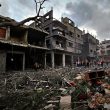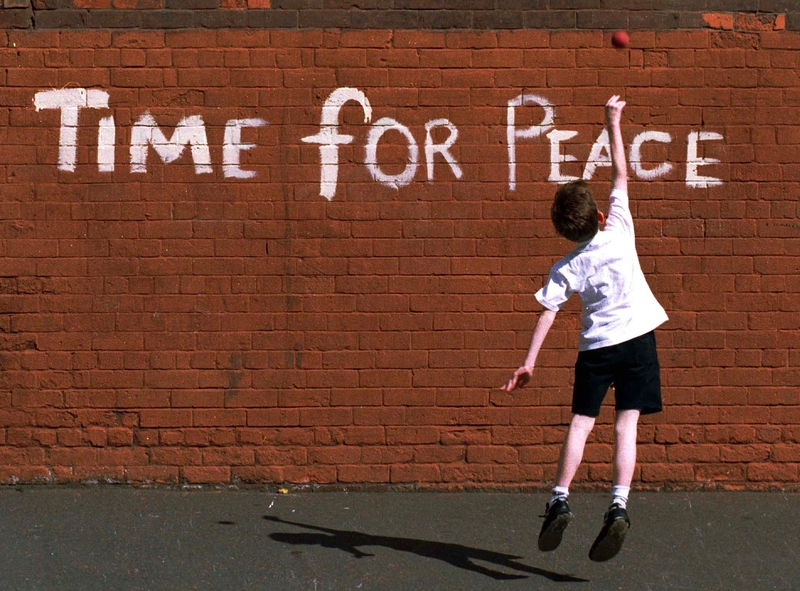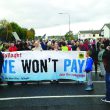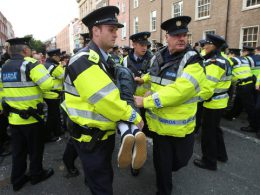By Ciaran Mulholland
In 1994, the IRA and Loyalist paramilitaries called ceasefires. Four years later the Good Friday agreement was declared to mark the end of the ‘Troubles’. The promised peace and prosperity, however, have proved elusive – and sectarian tensions are on the rise again.
Twenty years ago, the Provisional IRA called a ceasefire, followed a few weeks later by the main Loyalist paramilitaries. After decades of bloody conflict, with thousands killed, injured and imprisoned, there was general relief in working-class communities. The key factors behind the 1994 ceasefires were war weariness on all sides of the population, a military stalemate and the conclusion reached by Sinn Féin leaders, like Gerry Adams and Martin McGuinness, that the party could not make further political advances while the IRA’s armed campaign continued.
It was an important milestone in what became known as the ‘peace process’, which eventually saw the 1998 Good Friday agreement that secured the ceasefires, the ‘demilitarisation’ of much of the British state’s repressive apparatus, the release of hundreds of paramilitary prisoners, the decommissioning of IRA weapons, and the formation of the power-sharing Northern Ireland Executive. The peace process has been promoted as the ‘model’ for other seemingly intractable conflicts around the world. But two decades on, has it brought the stability, peace and prosperity much vaunted by local politicians and the British, Irish and US governments?
The Northern Ireland Executive has been in a rolling crisis for two years. One issue after another threatens its very existence, and that of the Northern Ireland assembly. Now (mid-October) talks involving the five parties with seats on the Executive have convened with the aim of resolving the ‘outstanding issues’. In an earlier attempt to reach cross-party agreement the Democratic Unionist Party (DUP) and Sinn Féin convened talks between all the main parties, chaired by US diplomat Richard Haas, on issues around flags, emblems, parades and the past. The talks concluded in the last days of 2013, and ended in spectacular failure. This time around the same contentious issues are on the table. In addition, the need to reach agreement on a governmental budget – or, where the cuts should fall – is also up for discussion.
The peace process has not delivered real, sustainable jobs or any relief from poverty for either Catholics or Protestants. A comprehensive survey by the University of Ulster, published in August, found that areas which suffered the most from violence during the ‘Troubles’ are the biggest losers of the peace process. The author of the study concluded that “there has been no peace dividend for those living in the most deprived areas of Northern Ireland”. Welfare dependency has risen and suicide rates have doubled – from around eight to 15 suicides per 100,000 people in these areas between 1999 and 2010. Male life expectancy is six years less than for males in more affluent parts of Northern Ireland.
The cuts being implemented by the British government and the Northern Ireland assembly are deepening the despair and alienation which fuel sectarianism. All the political parties on the Executive agreed to carry out £4 billion of cuts in the North when the Con-Dem government came to power. The DUP is open in its support for vicious cuts to welfare. Electoral considerations for Sinn Féin, primarily in the South, mean that it needs to pose as being against ‘welfare reform’. In fact, Sinn Féin voted with the other parties on the Executive to increase the retirement age of public-sector workers, to increase pension contributions, and for smaller pensions on retirement. Despite the sound and fury, more than 50% of cuts to welfare have already been made, and were agreed by Sinn Féin.
Nevertheless, disagreement over the implementation of welfare cuts, and the inability of the Executive to put off sharp cuts any further, have caused a financial crisis this autumn. Dramatic cuts across the board loom. Up to 15% may be taken from the budgets of the universities and further education colleges, for example. In early October the immediate crisis was defused when £100 million of next year’s budget was brought forward. The real ‘solution’, which both the DUP and Sinn Féin clearly favour, is the implementation of at least 6,000 redundancies (perhaps as many as 13,000) in the public sector.
Parades and the past
The crisis has to be seen against the background of the fractious atmosphere around the Executive table over the last two years. The main parties were never comfortable coalition partners. However, the unrest and violence on the streets, after protests over the regularity of flying the Union flag at Belfast city hall erupted in early December 2012, soured the atmosphere even further. There is now only a small weekly city centre protest in Belfast but bitterness around the flag issue in Protestant working-class areas remains. Over 800, mainly young Protestants have been arrested during the protests, and many remain in prison.
In July 2013 an Orange Order march was prevented from proceeding past the Ardoyne shops in North Belfast and a standoff in the area has continued ever since. Day-to-day politics is often dominated by such issues, and concerns regarding ‘the past’ and the rights of the ‘victims and survivors’ of the Troubles. There are sharp disagreements between the parties, and all attempts to reach consensus and compromise have failed.
In the last week of February, a major crisis rocked the Executive and almost brought it crashing down. It erupted when charges were dropped against John Downey, a republican suspected of carrying out the Hyde Park bombing in London in 1982 which killed four soldiers. It had emerged that Downey had received a letter assuring him that he was not wanted by the authorities and it quickly became clear that 200 or so other individuals had received similar letters over the last number of years.
As soon as Downey walked free, a storm of protest erupted and DUP First Minister, Peter Robinson, threatened to resign claiming that he knew nothing about what he termed the get-out-of-jail-free letters. Instead, within 36 hours, Robinson dropped his threat to resign, saying that a promised British government inquiry meant that the letters were now “useless pieces of paper”.
A second major crisis erupted on the evening of 30 April when Sinn Féin president, Gerry Adams, presented himself to the police service of Northern Ireland for questioning over the 1972 murder of Jean McConville. Now Adams is once again under intense scrutiny accused of covering up a case of alleged child abuse involving a senior IRA member. Further allegations against various Sinn Féin and IRA members are likely to surface in the coming days. The brutality of Jean McConville’s death, and the public attitude of Sinn Féin to the cases of child abuse, sickens many, and there are increasing calls for these issues to be dealt with in the inter-party talks. There is, of course, little chance that they will be and no chance of any satisfactory resolution.
The only way to achieve justice is to ensure that we do not return to our grim past. Working-class people suffered most during the Troubles and the workers’ movement has a duty to expose the crimes of the political forces which whipped-up sectarianism, and often continue do so, even while they call for justice for the victims. The workers’ movement must also expose the crimes of the state – the establishment must not be allowed to avoid responsibility for the violence of state forces. Learning the necessary lessons of the past would be a fitting memorial for those who died.
Sharp disagreement around the route and conduct of parades of the Orange Order and similar organisations continue to spark conflict on the streets. Increasingly, Sinn Féin-influenced residents’ groups are being challenged for supremacy in Catholic areas by dissident republican-influenced groups. The former will sometimes countenance compromise, though their approach remains based on promoting division. The latter have certainly drawn the conclusion that compromise is wrong and unnecessary, and that confrontation and conflict work. Many in the Protestant community, not just those who are members of the Orange Order, see the Parades Commission as one-sided. In working-class areas a general sense that ‘we have no more to give’ has developed.
The current war of attrition is leading nowhere except in the direction of greater conflict. The prolonged trouble over the flying of the union flag during the winter and spring of 2012-13 is a stark warning for the future. ‘Peace’ is only maintained by dozens of permanent ‘peace-lines’ – walls and barriers separating communities – thousands of armed police, and the local enforcement activities of paramilitary groups interested primarily in control of ‘their’ areas. When all this is insufficient, temporary steel peace-lines are thrown up and hundreds of extra police are drafted in from England, Scotland and Wales.
Difficult negotiations
The Socialist Party has long argued that competing rights are at stake in the conflict over parades. The Orange Order is a right-wing organisation which is sectarian in complexion and intent. Despite this, it has the right to march, just as the many other sectarian groups and political parties in Northern Ireland have the right to organise and march. Recognising this right is in no way an acceptance of the policies or positions of sectarian forces, on both sides of the divide.
Local residents have the right to object to provocative parades. A clear distinction has to be made, however, between residential areas, such as housing estates, and main roads and town and village centres. The situation is more complex when main roads skirt residential areas but the principle remains the same: residents must recognise the need to ‘share’ main roads which are arterial routes for both communities. The hard-line position, not always openly expressed but often implicit in the opaque statements of residents’ groups, that there should be ‘no Orange feet’ on this or that road, is not a negotiating position.
As well as the rights of each community, expressed separately, there is the more important right of the working class as a whole not to be dragged into serious sectarian conflict over the issue of parades. This is not an abstract question but represents the wishes and aspirations of the majority of the working class and youth who yearn for a better future but who often cannot see how this can be realised. The position of the Socialist Party on the parades issue has been isolated at times but in many ways has come to be accepted by wide layers. This is precisely because it represents the aspirations of the many and because the organic unity of the working class has not been broken despite decades of violence and the betrayals of the trade union leaders.
The long-term approach of the Orange Order – that it can march where it chooses without negotiation – is unacceptable. Agreement must be reached around the frequency and conduct of parades, including who takes part in and accompanies them. Often it is drunken and abusive crowds following parades which cause the most trouble. Each side should steward its own supporters to ensure peace. When the police come into areas it almost inevitably increases tension and the risk of violence.
Cuts and resistance
Despite the reality of working people’s lives, the Executive trumpets the ‘recovery’ like all administrations across Europe. Such an approach may backfire: if the economy is picking up, working-class people will ask, ‘where is our recovery?’ The sense that it amounts to no more than the rich piling up even greater profits will deepen anger on living standards. In the run-up to next year’s general election a generalised movement on pay may develop as workers fight for a real pay rise.
The key reason why an anti-cuts struggle has not developed to a greater extent over the last period is that most of the trade union leaders in Northern Ireland, as in England, Scotland and Wales, consciously demobilised the movement which was developing in the autumn of 2011. The one-day public-sector strike on 30 November 2011 was an outstanding success but was followed within days by an organised betrayal on pensions. Since then it has been very difficult to convince working-class people, including activists, that a fight-back is possible.
Public-sector workers have suffered real pay cuts of 10-15% or more. The Con-Dems and the Northern Ireland Executive have made it clear that the ‘recovery’ does not mean any let up in the cuts, including in pay. Now, precisely because of the scale of the cuts facing the working class, united action is possible, beginning with a one-day public-sector strike across Northern Ireland against redundancies, attacks on services and pay freezes.
The local and European elections again illustrated the lack of a viable and credible political alternative for most people in Northern Ireland – there were only a handful of candidates who represented an alternative in any sense. There is no mass party which has a base in both Protestant and Catholic areas, and which speaks up for trade union members and working-class people in general.
Half of potential voters do not turn out to vote. There are many reasons for this, of course, but large numbers do not vote in disgust at the antics of sectarian parties. Nonetheless, the Socialist Party argues that it is possible to build a mass party which wins votes in both communities by putting forward policies which unite working-class and young people. Saying that it is possible, however, is not to say that it is easy. There are many barriers in our way. Even the layers who have ‘had enough’ of the status quo do not see any alternative out there.
The DUP remains the largest unionist party, although the Euro elections saw a significant challenge from Jim Allister of Traditional Unionist Voice (TUV) and a UKIP candidate who between them won over 100,000 votes. In the local elections, the DUP saw its vote fall by 4.1%. It lost 15 council seats. The Progressive Unionist Party (PUP), linked to the paramilitary Ulster Volunteer Force, received nearly 13,000 votes, winning four seats and coming close to taking several more. The TUV made significant gains in the local elections, going from three seats to ten, and winning 9% of the unionist vote.
Sinn Féin topped the poll in the Euro elections with 25% first preferences but was not immune to a growing anger in Catholic working-class areas. It lost ten council seats and its share of the vote dropped slightly by 0.7%. Significantly, it lost a seat in its heartland of West Belfast to People Before Profit. In Derry and Strabane, a number of independents were elected in Catholic areas. Gary Donnelly, of the 32-County Sovereignty Movement (linked to the Real IRA), stood as an independent and topped the poll with 1,154 votes in one area of Derry.
Donnelly is one of the most prominent dissident republican spokespersons and is publicly seen as a voice for republicans who are involved in armed attacks on the state. There is clearly a layer in Catholic working-class areas which is disaffected and looking for an alternative. In a number of areas this mood was captured by candidates who are linked to various shades of dissident republicanism but who sometimes stood on an anti-cuts platform. All of these candidates targeted Sinn Féin for its role in implementing the cuts.
The results of the elections represent a clear warning for the trade union and working-class movement. The votes for hard-line unionist parties, such as the TUV, the PUP and UKIP, reflect the turmoil on the streets over the issue of flags over the last 18 months. The votes for candidates who represent the various strands of dissident republicanism reflect the increased alienation of layers of working-class Catholics.
Building class unity
An important development in the elections was the support that trade unions gave to working-class candidates. Unite gave financial support to both Socialist Party candidates – Tommy Black in the Titanic ward and Paddy Meehan in the Botanic ward, both in Belfast. Unite also gave support to Socialist Party member Donal O’Cofaigh who stood as an anti-fracking candidate in Fermanagh and just missed out winning a seat. The Fire Brigades Union continued its proud record of backing working-class and socialist candidates.
The victory of Gerry Carroll, standing as People Before Profit in West Belfast, is a positive indication of the mood. He was a strong local candidate and is seen as being prepared to work hard on the ground and take up issues that affect working-class people. He also gained trade union support. A new party in Northern Ireland must be based on trade unionists, those community activists who are not tied to the sectarian parties, and young people who reject the sterile status quo. To build mass support on the ground a new party would need actively to combat sectarianism in all its forms and pose an alternative to the right-wing policies of the old parties.
Councillors who are linked to dissident republicanism in any way are not capable of building a real alternative. It is important that socialists take positions which are clearly independent of both sectarian camps, especially on issues reflecting sectarian division. It is vitally important to have a clear view of the interests of the working class as a whole.
The unions must actively combat sectarian threats and attacks in the workplaces and communities, through united protests and strike action when necessary. In the past, such action was successful in cutting across the drift to more widespread and deeper conflict on a number of occasions. The leadership of the trade unions has abdicated all responsibility for the lives and futures of working-class people in Northern Ireland, choosing instead to cosy-up to the assembly parties. The working class deserves trade union leaders who are prepared to fight. Creating such a leadership requires the ejection of most of the current leaders from their positions.
The vast majority of working-class and young people are opposed to any return to conflict. They cannot rely on the assembly to deliver lasting peace, a decrease in sectarian division or improved living standards but must rely, instead, on their own strength. Only the workers’ movement, primarily the trade unions, can provide a real and viable alternative to sectarianism and conflict. If the trade union movement were seriously to mobilise its quarter-of-a-million members in a struggle against the cuts, an issue which unites Protestant and Catholic workers, this would allow the dynamic of the situation to swing in the direction of class struggle and class unity.












